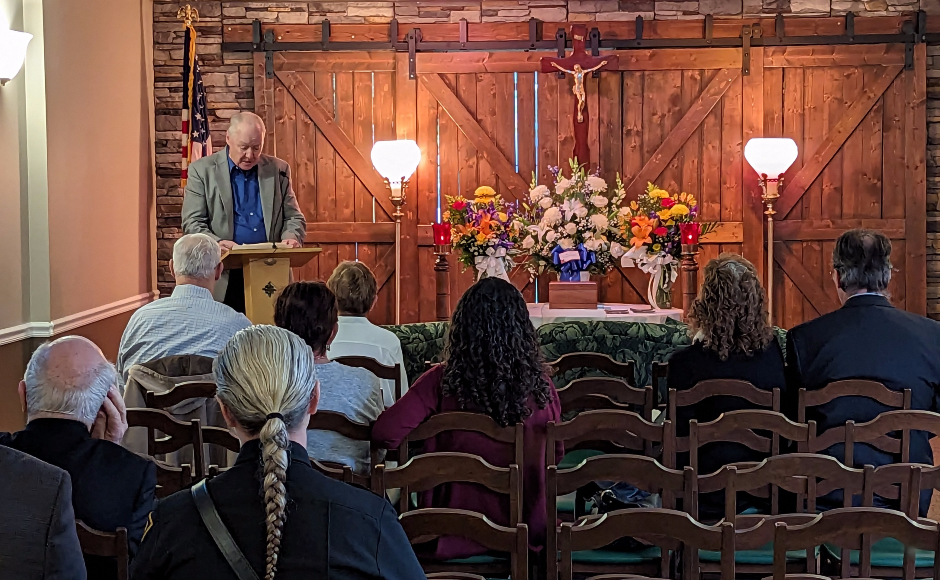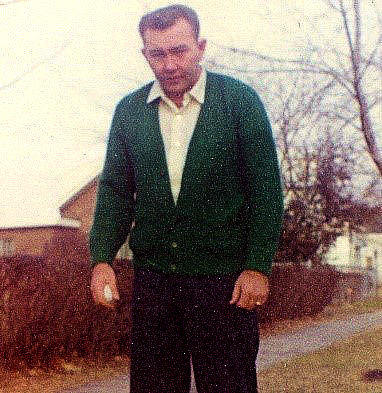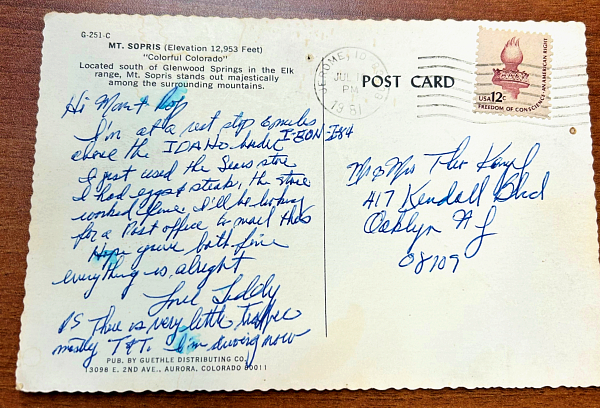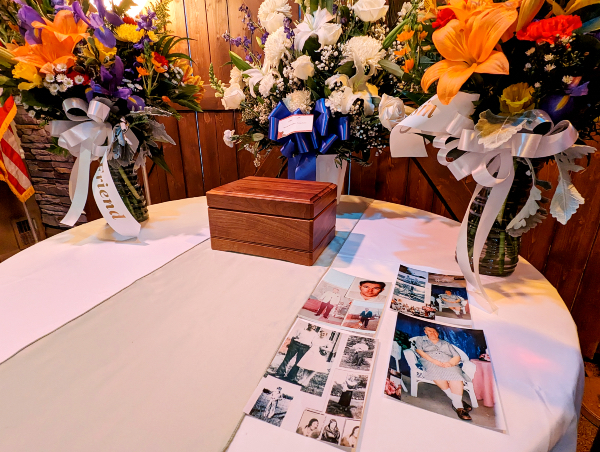Teddy Kampf’s was the longest missing persons case in the history of Oaklyn. Thanks to the persistence of investigators and the promise of a family friend, his remains finally were identified and laid to rest.
By Matt Skoufalos | April 3, 2023
On Saturday, April 1, Theodore “Teddy” Kampf of Oaklyn was laid to rest in New Jersey, nearly 40 years after he’d left the state.
The only son of Theodore F. and Mary Kampf went missing in the Yukon Territory in the summer of 1981, along with about $5,000 in travelers checks and his brand new Chevy pickup.
Teddy had been poised to explore the area around Dawson City, an outpost along the historic Klondike gold rush that was experiencing a resurgence in prospecting interests at the time.
He crossed the Canadian border sometime in mid-July 1981, as per the last telephone call his parents received from him.
Less than three months later, they opened a missing persons investigation with Oaklyn Police.
That case passed through the hands of generations of detectives in the cold case unit, including former Oaklyn Chief Joseph Abbate and current Chief Jayne Jones. Both were on hand Saturday at Teddy’s wake, as was Oaklyn Detective Paul Mason, with whom the case rests today.
Through their efforts, and those of investigators across the border in the Royal Canadian Mounted Police (RCMP), Teddy’s remains were finally positively identified through genetic testing two summers ago.
That technology — like cellular phones, satellite mapping, and e-mail, all of which are fundamental to police work today — wasn’t available to investigators for years after his death. And when it did arrive, the database coordination and international agreements that facilitate its use weren’t established until decades later.
Despite a few noteworthy wrinkles in the case, including Teddy’s truck turning up crashed in Idaho two weeks after he’d crossed into Canada (and again in Montana in February 1982), and forged signatures on his traveler’s checks, the trail went cold.
Theodore F. Kampf died in 1995, and Mary Kampf in 2002, neither having ever learned their son’s ultimate fate. When the case passed to Jones in 2010. It hadn’t generated a new lead in decades, but she pored over the evidence again and again, searching for a break.
Jones was captivated by the case, she recalled, not only for its details, but for its status within the department. Teddy’s was the longest unsolved missing persons case in its history; Jones felt more like she was inheriting it from her forebears rather than accepting an assignment.
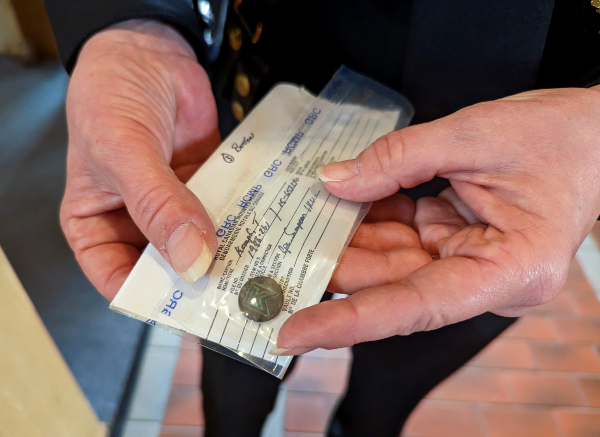
Oaklyn Police Chief Jayne Jones displays a button from Teddy Kampf’s clothing, provided by the RCMP. Credit: Matt Skoufalos.
“I had the opportunity of working with some of those detectives, and we would speak about Teddy’s case,” Jones said.
“I can tell you he was never forgotten by the Oaklyn Police Department,” she continued, nor the RCMP, with whom Jones corresponded in her efforts to solve it.
Neither did Michael McMenamin, a retired U.S. Customs Investigator from Haddon Township, forget about Teddy’s case.
Since 1997, when he met Mary Kampf through a church outreach program, McMenamin had been turning the story over and over in his head.
“At that point, she was a widow, legally blind, and starting to deal with dementia,” he recalled. “She was very tough to work with, but sitting at her kitchen table, she’s telling me these stories about her son.
“She had consulted a psychic,” McMenamin said. “And she pulled out a 1981 Courier-Post article with the whole story in it. I realized this is for real.”
McMenamin didn’t dwell on the details of the story in Mary’s presence, but quietly began consulting with Oaklyn Police on the case, using his spare time to think on it, and occasionally reaching out with new ideas or questions.
“Whatever detective was working it, whoever I talked to, I would say, ‘Have you looked at this this or that? What’s the latest? What’s the update?’” he said.
“I didn’t tell Mary that I was working this, or make any promises to her, because I didn’t want to offer any false hope.”
Jones agreed that the work was slow-going, and hope was occasionally in short supply.
“Throughout Teddy’s case, you’d get to a certain point, and you were stonewalled,” Jones said. “There were always these variables that were there.”
After the Chevy went missing, Oaklyn Police weren’t notified until months after it had been crashed twice. Jones tried to identify Teddy’s remains through dental records, but there was “a SNAFU” with their characterization in Canada, she said. More delays followed at some point because RCMP investigators had been in contact with police in Oakland (Bergen County) and not Oaklyn, New Jersey.
But for as much as time was lost in the early days of Teddy’s disappearance, immeasurably more waited in reserve. While studying forensic anthropology, Erin McMenamin introduced her father to NamUs, the National Missing and Unidentified Persons System. The database project, which compares genetic data from unidentified crime victims against missing persons cases, “kickstarted the case again,” Michael McMenamin said.
“That helped me create my own record for him, because it’s a clearinghouse for anybody to help search for missing or unidentified people,” he said.
Jones thought the stamp from Teddy’s last postcard to his parents might be a source of some useful genetic information, but researchers said they couldn’t know whether he had been the one to lick it.
Instead, she worked with McMenamin to collect DNA samples from Teddy’s cousins, Bonnie DeFeo and Frank Kampf.
They hadn’t had a personal relationship with Teddy, but their DNA helped move the case along; another distant cousin in Canada, who’d submitted material through an ancestral DNA service, provided the necessary link across the border.
Although the correspondence didn’t offer usable DNA, it did provide another useful lead to investigators. Teddy wrote that he’d had steak and eggs for breakfast in a Sears stove they’d given him for the trip. In another letter, he’d mentioned using the same stove to cook potatoes while he wrote to his parents. It concluded, “PS – the potatoes are done and I had to sew the seat of my dungarees.”
As Jones pored over those details with RCMP Constable Ed Simpson, “it was like a bell went off in his head,” she said.
“It was silent, and then he said, ‘I believe we have your missing person here,’” Jones said.
Details later revealed that the remains found in Canada had been buried in a shallow grave with a Sears camping stove and American-made jeans that had been mended by hand.
When Jones visited McMenamin at home to tell him the news — that, after 26 years of nudging and probing and tracking down loose ends, Teddy’s remains had been identified — he hugged her through her armored jacket.
What began as a promise to a neighbor had ended up as the longest case of his life.
“It was a puzzle that wasn’t answered,” McMenamin said. “I felt bad for [Mary]. Life changed for her completely when this happened. She was never the same; the husband grieved for years.
“I started something,” he said. “How can I walk away from it with a clear conscience?”
Whether due to his conscience or personal curiosity, it was McMenamin’s singular persistence that helped keep the case alive, Jones said.
“The fact Mr. McMenamin kept that promise all of these years to an elderly stranger he had met in a nursing home, and who had since passed away — let me just say that level of commitment is not easily compared,” she said.
Neither did McMenamin shrink from the work of helping lay Teddy to rest.
With the help of Dennis McGee and Creran Celebrations of Oaklyn, Teddy’s remains were repatriated, and his wake and interment were provided pro bono.
Outside of his family, “Dennis and Jayne are the only other people I’ve ever hugged on the matter,” McMenamin said.
“It’s important to us to mark it with significance, have some sort of gathering, have a memorial,” McGee said. “I’m just happy to have been a part of this.”
With so few living relatives who could recollect him, the work of memorializing Teddy was difficult to do. Neither did McGee want the ceremony to be preoccupied with the circumstances of Teddy’s death and disappearance.
“It was really difficult to imagine who he was, and nobody knew who he was,” said McGee, who wrote Teddy’s obituary. “[We had] what people had to say about him in a podcast, what his mom said about him, what we saw in pictures.”
Instead, McGee wrote that Kampf “possessed an innate wanderlust… was an avid photographer, and could easily get lost in National Geographic Magazine.”
Born in Philadelphia, and an Oaklyn lifer thereafter, Kampf was also a U.S. Army Reservist, an electrical engineer who designed circuits for Bell Telephone, and who had traveled to Tennessee and Arizona before making his way to the Pacific Northwest.
Speaking at his wake, McMenamin touched on the years that had passed since Teddy set out on the open road, and how those who missed him had spent them.
“Something that came to me in my daily readings is that there’s always a message in the mess,” he said.
“I think the message here is to never lose hope or faith.”
Although the prospects may be dim of ever closing the books on Teddy’s killer or killers, no one involved in his case has given up hope that justice may be served.
McMenamin plans to stay in contact with the RCMP and on top of the genetic data.
Jones thinks about planning a motorcycle trip to Phillipsburg, Montana, where his car was found.
“I would love to retrace all his steps,” she said. “That would be the closure.”
“The people who did this to him; I’m a true believer in karma, and I have faith that when our time comes, we have to answer for our sins,” Jones said.
“I’m happy, but it’s bittersweet,” she said. “I still want justice for him.”

